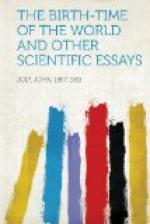22
REVIEW OF THE RESULTS
We shall now briefly review the results on the geological age of the Earth.
By methods based on the approximate uniformity of denudative effects in the past, a period of the order of 100 millions of years has been obtained as the duration of our geological age; and consistently whether we accept for measurement the sediments or the dissolved sodium. We can give reasons why these measurements might afford too great an age, but we can find absolutely no good reason why they should give one much too low.
By measuring radioactive products ages have been found which, while they vary widely among themselves, yet claim to possess accuracy in their superior limits, and exceed those derived from denudation from nine to fourteen times.
In this difficulty let us consider the claims of the radioactive method in any of its forms. In order to be trustworthy it must be true; (1) that the rate of transformation now shown by the parent substance has obtained throughout the entire past, and (2) that there were no other radioactive substances, either now or formerly existing, except uranium, which gave rise to lead. As regards methods based on the production of helium, what we have to say will largely apply to it also. If some unknown source of these elements exists we, of course, on our assumption overestimate the age.
23
As regards the first point: In ascribing a constant rate of change to the parent substance—which Becker (loc. cit.) describes as “a simple though tremendous extrapolation”—we reason upon analogy with the constant rate of decay observed in the derived radioactive bodies. If uranium and thorium are really primary elements, however, the analogy relied on may be misleading; at least, it is obviously incomplete. It is incomplete in a particular which may be very important: the mode of origin of these parent bodies—whatever it may have been—is different to that of the secondary elements with which we compare them. A convergence in their rate of transformation is not impossible, or even improbable, so far as we known.
As regards the second point: It is assumed that uranium alone of the elements in radioactive minerals is ultimately transformed to lead by radioactive changes. We must consider this assumption.
Recent advances in the chemistry of the radioactive elements has brought out evidence that all three lines of radioactive descent known to us—i.e. those beginning with uranium, with thorium, and with actinium—alike converge to lead.[1] There are difficulties in the way of believing that all the lead-like atoms so produced ("isotopes” of lead, as Soddy proposes to call them) actually remain as stable lead in the minerals. For one
[1] See Soddy’s Chemistry of the Radioactive Elements (Longmans, Green & Co.).
24




